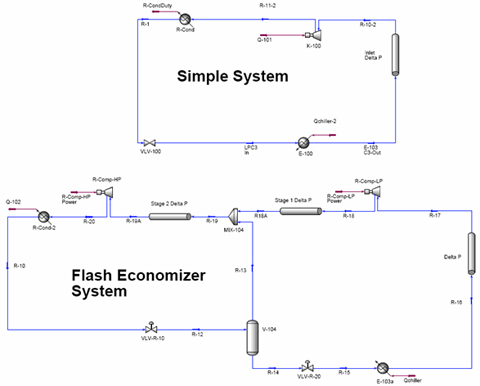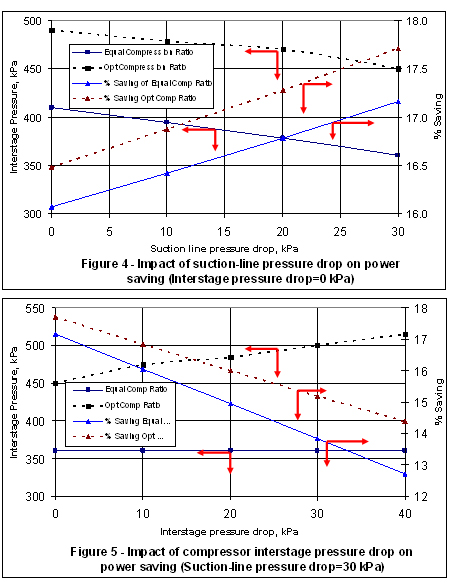In this Tip of the Month, we will compare the performance of a simple refrigeration system with another one employing a flash economizer. Specifically, we will evaluate compressor power saving, the effects of compressor suction–line pressure drop and the interstage pressure drop on compressor power requirement and condenser duty.
The objective of a refrigeration system is to “pump” low temperature heat from the process fluid to high temperature (ambient) where it is rejected to the environment. Energy is required to pump heat. The amount of energy depends on the quantity of heat to be “pumped’ (chiller duty) and how far the heat has to be pumped (temperature difference between the chiller and the condenser). Compression refrigeration is by far the most common mechanical refrigeration process. It has a wide range of applications in the gas processing industry. It provides chilling for:
- NGL extraction, LNG production, and LPG product storage
- Hydrocarbon and water dew point control
- Reflux in deethanizers/demethanizers
The details of a simple single-stage refrigeration system and a two-stage refrigeration system employing one flash tank economizer are given in Chapter 16 of Gas Conditioning and Processing, Volume 2 [1]. The process flow diagrams for the simple and with flash economizer refrigeration systems are shown in Figure 1. Note that provisions have been made to consider pressure drop in different segments of the loops.
Figure 1. Process flow diagram for the simple and flash economizer refrigeration systems
Let’s consider removing 1.0×107 kJ/h (2778 kW) from the process gas at -35°C and rejecting it to the environment by the condenser at 35°C. Assuming 5 kPa pressure drop in the chiller, the compressor suction pressure is 132.4 kPa. The condenser pressure drop plus the pressure drop in the line from the compressor discharge to the condenser was assumed to be 50 kPa; therefore, compressor discharge pressure is 1270 kPa. Pure propane is used as the working fluid. The effect of impurities in the working will be discussed in the future Tip of the Month. In this study, all of the simulations were performed by HYSYS software [2].
For the case of with flash economizer and assuming no pressure drop between the two stages and in the suction line, Figure 2 presents the variation of the compressor interstage and total power as a function of the interstage pressure. As can be seen in this figure, the optimum interstage pressure is about 490 kPa. This pressure corresponds to the minimum total power. However, the ideal optimum interstage pressure based on equal compression ratio can be found by ![]() kPa. Figure 3 also presents the locations of these two optimum pressures.
kPa. Figure 3 also presents the locations of these two optimum pressures.
In order to study the effect of pressure drop in the compressor suction line on the total power requirement and condenser duty, the interstage pressure drop was set equal to zero. The suction line pressure drop was varied from 0 to 30 kPa with an increment of 10 kPa. Two sets of simulations were performed:
- The interstage pressure was determined based on the equality of compression ratio
- The interstage pressure was determined by minimizing the total compressor power
In each case, the total compressor power for the flash economizer system was compared with the power requirement for the simple refrigeration system and the percent of power savings were calculated.
Next, the effect of the interstage pressure drop on the total compressor power requirement and condenser duty was investigated. This was done by setting the compressor suction line pressure drop to 30 kPa and varying the interstage pressure drop from 0 to 40 kPa by an increment of 10 kPa. The load of interstage pressure drop was equally distributed between the two stages of compression. Again, the simulation results of flash economizer were compared with those of the simple refrigeration system. The summary of the results is shown in Table 1. Figures 4 and 5 are the graphical representation of the results presented in Table 1.
Table 1. Comparison of the results based on the equality of compression ratio and minimizing the total power requirement
Table 1 indicates that the power saving ranges from 12.7 to 16.1 % when a flash economizer is used in place of the simple refrigeration system, using interstage pressure based on the equality of compression ratio. However, if the interstage pressure is determined based on minimizing the total compressor power requirement, the power saving will be from 14.4 to 16.5 %. The interstage pressure drop is unique to flash economizer and its effect is the reduction of the power saving when compared to the simple refrigeration system and increases the condenser duty.
To learn more about similar cases and how to minimize operational problems, we suggest attending our G4 (Gas Conditioning and Processing) and G5 (Gas Conditioning and Processing – Special) courses.
By Dr. M. Moshfeghian
Reference:
- Campbell, J.M., “Gas conditioning and Processing, Vol 2: The Equipment Modules”, 8th Edition, Edited by R.A. Hubbard, John M. Campbell & Company, Norman, USA, 2000.
- ASPENone, Engineering Suite, HYSYS Version 2006, Aspen Technology, Inc., Cambridge, Massachusetts U.S.A., 2006.





Dear Dr. Mahmood,
I am a Process Engineer with CH2 MHILL Abu Dhbai. I read your article and found it very interesting. I have a doubt. Let’s suppose we have 3 users at process outlet temperatures of 6°C(3rd chiller), -8°C(2nd chiller) and -24°C(1st chiller). We can achive this by C3 ref. at 3 diff pressure levels corresponding to C3 temp of 0°C, -14°C and -30°C (assuming an approach of 6°C). In this case, the vapor from the 1st chiller will be compressed to the pressure of the vapor of the 2nd chiller and these combined vapor will be compressed to the pressure of the vapor of 3rd chiller and then finally all the vapor will again be compressed. My question is, in such cases, where we have multiple users, do we have an economizer as we have in case of a single user? If we do, what will be it’s operating pressure? I will be greatful if you clear my doubt.
Thanks,
Rahul Mukherjee
Dear Dr. Moshfeghian
Salam
I am a process engineer and I come across your fantastic article in John Campbell website, and I really enjoy it. It would be a great honor for me to be in touch and consult with you on different cases.
Best regards
Reza Panahi
[…] M., “Refrigeration with Flash Economizer vs Simple Refrigeration System,” […]
[…] M., “Refrigeration with Flash Economizer vs Simple Refrigeration System,” http://www.jmcampbell.com/tip-of-the-month/2008/01/refrigeration-with-flash-economizer-vs-simple-ref… , […]
At this moment I amm going away to do my breakfast, when having my breakfast
comin yet again to read other news.
My page – nsa encounters (Victor)
Together with everything that seems to be building throughout this subject matter, all your perspectives are generally somewhat refreshing. Even so, I beg your pardon, but I can not subscribe to your entire suggestion, all be it radical none the less. It seems to everybody that your commentary are not completely validated and in simple fact you are yourself not really completely certain of the argument. In any case I did appreciate looking at it.
At this time it appears like Movable Type is the best blogging platform available right now. (from what I’ve read) Is that what you are using on your blog?
Hi blogger, do you monetize your website ? There is easy method to earn decent money every day,
just search on youtube – How to earn $25/hour selling articles
[…] M., http://www.jmcampbell.com/tip-of-the-month/2008/01/refrigeration-with-flash-economizer-vs-simple-ref…, Tip of the Month, January […]
[…] M., http://www.jmcampbell.com/tip-of-the-month/2008/01/refrigeration-with-flash-economizer-vs-simple-ref…, Tip of the Month, January […]
Comprehending the appropriate question to ask is actually far more important as compared to having a prepared reply. Good questions challenge your thinking. Research studies are rather lucid that we value people that pay attention to us. Our objective and goals are certainly at the heart of who we are and who we need to be. In the simplest of terms, proper questions are our instrument for aiding to see the genuine reality around us instead of murky depictions of it. Ask fundamental questions concerning the things which everybody else takes for certain. People are compassionate. They desire to have a fantastic dialog with you. We accomplish things for many different purposes. As you ask somebody about what satisfies them, it opens the entrance to discovering something that is obviously exclusively for this person. It may be a sensationa moment in time for others while you encourage them to reveal their aspirations with you. There are occassions when you don’t have to produce advice.
[…] M., http://www.jmcampbell.com/tip-of-the-month/2008/01/refrigeration-with-flash-economizer-vs-simple-ref…, John M. Campbell Tip of the Month, January […]